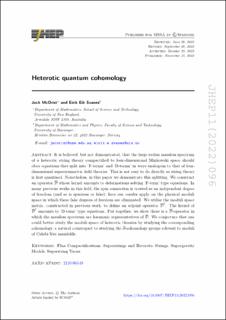| dc.contributor.author | McOrist, Jock | |
| dc.contributor.author | Svanes, Eirik Eik | |
| dc.date.accessioned | 2023-03-15T13:22:29Z | |
| dc.date.available | 2023-03-15T13:22:29Z | |
| dc.date.created | 2022-12-05T14:25:50Z | |
| dc.date.issued | 2022-11 | |
| dc.identifier.citation | McOrist, J., Svanes, E.E. (2022) Heterotic quantum cohomology. Journal of High Energy Physics (JHEP), 96 (2022) | en_US |
| dc.identifier.issn | 1126-6708 | |
| dc.identifier.uri | https://hdl.handle.net/11250/3058469 | |
| dc.description.abstract | It is believed, but not demonstrated, that the large radius massless spectrum of a heterotic string theory compactified to four-dimensional Minkowski space should obey equations that split into ‘F-terms’ and ‘D-terms’ in ways analogous to that of four-dimensional supersymmetric field theories. This is not easy to do directly as string theory is first quantised. Nonetheless, in this paper we demonstrate this splitting. We construct an operator D¯ whose kernel amounts to deformations solving ‘F-term’ type equations. In many previous works in this field, the spin connection is treated as an independent degree of freedom (and so is spurious or fake); here our results apply on the physical moduli space in which these fake degrees of freedom are eliminated. We utilise the moduli space metric, constructed in previous work, to define an adjoint operator D¯†. The kernel of D¯† amounts to ‘D-term’ type equations. Put together, we show there is a D¯-operator in which the massless spectrum are harmonic representatives of D¯. We conjecture that one could better study the moduli space of heterotic theories by studying the corresponding cohomology, a natural counterpart to studying the ∂¯-cohomology groups relevant to moduli of Calabi-Yau manifolds. | en_US |
| dc.language.iso | eng | en_US |
| dc.publisher | Springer Nature Switzerland AG | en_US |
| dc.rights | Navngivelse 4.0 Internasjonal | * |
| dc.rights.uri | http://creativecommons.org/licenses/by/4.0/deed.no | * |
| dc.subject | fysikk | en_US |
| dc.title | Heterotic quantum cohomology | en_US |
| dc.type | Peer reviewed | en_US |
| dc.type | Journal article | en_US |
| dc.description.version | publishedVersion | en_US |
| dc.subject.nsi | VDP::Matematikk og Naturvitenskap: 400::Fysikk: 430 | en_US |
| dc.source.pagenumber | 0 | en_US |
| dc.source.volume | 2022 | en_US |
| dc.source.journal | Journal of High Energy Physics (JHEP) | en_US |
| dc.source.issue | 11 | en_US |
| dc.identifier.doi | 10.1007/JHEP11(2022)096 | |
| dc.identifier.cristin | 2088858 | |
| dc.source.articlenumber | 96 (2022) | en_US |
| cristin.ispublished | true | |
| cristin.fulltext | original | |
| cristin.qualitycode | 2 | |

